|
FAQs on the Hydrozoan Compatibility
& Control
Related Articles: Hydrozoans,
Cnidarians, Fire Corals, Stylasterines, Hydrozoan Jellies, 'Coral' Compatibility: On Reducing
Captive Negative Interactions Cnidarians
by Bob Fenner, ppt. vers: Cnidarian Compatibility: On Reducing Negative
Cnidarian Interaction Parts: 1,
2, 3, 4,
5, by Bob Fenner
Related FAQs: Hydrozoans 1, Hydrozoans 2, Hydrozoan Identification,
Hydrozoan Behavior, Hydrozoan Selection, Hydrozoan Systems, Hydrozoan Feeding, Hydrozoan Disease, Hydrozoan Reproduction,
Medusoids/Jellies (Ctenophores, some Hydrozoans,
Scyphozoans): Jelly Identification, Jelly Behavior, Jelly Compatibility, Jelly Selection, Jelly Systems, Jelly Feeding, Jelly Disease, Jelly Reproduction, Fire Corals, Lace Corals,
Stinging-celled Animals
|
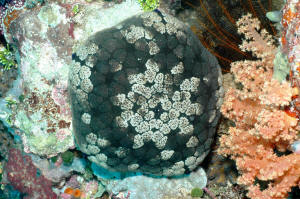 Some Hydrozoans can even
sting echinoderms. Some Hydrozoans can even
sting echinoderms.
|
|
re: Can't ID hair like growth in reef aquarium(SMALLER SIZED PICS)
9/6/17
Mr. Fenner
<Matthew!>
Here I bought a stereo microscope and took pictures of the pictures of the hair
like growth being told. Hydroid digitate, Bryozoan Bryopsis, algae of
unknown... Can someone please help me now??
<Mmm; well the color, strands remind me of algae... are there cell walls in the
strings? That is individual cells making parts of the strands? If not, perhaps a
blue green "algae". The expanded tips remind me of the ciliate Vorticella... how
big are these? Could be a digitate hydroid, but so green?
Sorry, can't make out more here. Bob Fenner>
Matthew
|
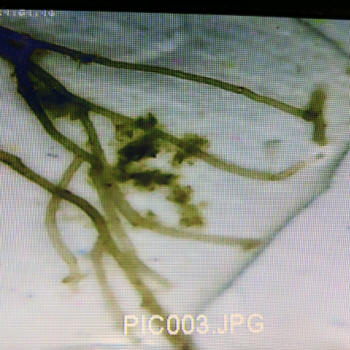
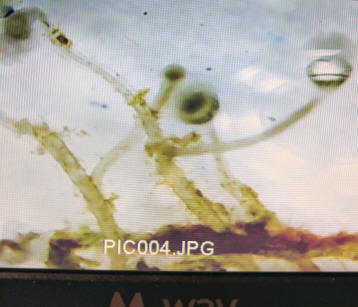 |
|
re: Can't ID hair like growth in reef aquarium (SMALLER SIZED PICS)
9/6/17
Some are 1/4" some maybe 1" but they come back quick...
<Umm; these are digitate hydroids... I'd be removing them>
Let me mess with the new Gadget it says up to 600x. I just held it with my hand
and focused as best as I could I'm going to suction it down to a piece of glass
I did add some distilled water to it I pulled it with tweezers from the base I
was hoping you could identify it by the circle tips at the ends of the object it
looks like a red blood cell but green this is what they look like at there
latest like largest... 1" tall Max. Look white not matter if I use a blue
flashlight or if I use a white flashlight they look the same until I pull them
out of the water then they are green right away I don't know if it's the
oxygenation or if they're just green and look white but they have no feeding
response when I feed my Montipora wouldn't a did you take hydrated have a
feeding response to Reef Roids or Coral Frenzy or even Cyclops I see no change
in anything actually the ones that have peaked in size have ingrown no more but
if I were to pull them off or toothbrush them they would come back not as fast
like tall wise but they come back on the Fred I brush them off when they were
very small and within two days they're still back to their very small stage of
maybe one 20th of an inch did you take my droid have a feeding response to reef
Roids or coral frenzy or even Cyclops I see no change in anything actually the
ones that have peed in size haven't grown no more but if I were to pull them off
or toothbrush them they would come back not as fast like tall wise but they come
back on the Fred's <?> I brush them off when they're very small and within 2
days there they're still back to their very small stage of maybe 1/20 of an
inch. ..
<Pull the affected rocks out... dry>
if I can't figure this out I'm going to trash the library and then quarantine
all my coral into a small 22 gallon frag tank because I'm worried that if I
toothbrush this stuff off put them into a new tank it will just start the
process all over again even though I'm using dry live rock next time or maybe I
will just frag pieces of SPS that don't have any
near it but it's the track of philia that I don't know if it has these things on
the small base underneath they don't grow on any fleshy Parts only on hard
surfaces except glass... I noticed them growing on my overflow wall there is
none in my refugium skimmer compartment because which is weird I have a 300 watt
Mars light and a macro reactor and a CFL light growing some red color for red
kelp tree like red grapes growing on a vine None but in the display...
<Thank goodness>
If I can't figure this out I'm going to most likely have to throw away a lot of
corals that I've been nursing back from that product vibrant liquid aquarium
cleaner and caused my anemones to basically shrivel up and it did nothing to
this stuff after five doses I will try to get a better photo more detailed of
the cell walls I mean the box of this microscope stereo microscope shows this
thing looking at organisms not just maybe that's the picture I took of this
stuff was maybe 40-50 X I mean looking at a hair is not that impressive when it
advertises 600x maybe it's the distance I had it at it was too close Maybe I
know it wasn't too far away... Just another question I bought some live rock
drive from BRS.
<... see others opinions.>
The curing process. Just sit in barrel for few months small WC every week maybe
and when no nitrite there ready? But how long do u leave em in there so there
actually live and not just the decay wearing off and no po4 leaching.,. Also
when I start so I have to seed with i.e. Biospira or an alrdy cured LR (NOT ONE
OF MINE) even though some have these things on them while some but taking the
risk isn't my biggest thing. I notice they don't sting cut irritate the sps and
stunting growth. I have my macroalgae reactor running now and I also reinstall
my algae Turf scrubber which the vibrant aquarium cleaner people told me to take
off line so I'm hoping after that I've already
noticed a tripling of my Chaeto that I put in there a very small amount that you
twist tie onto the plates and I'm also going to reinstall a new UV light I
haven't had a UV running for about 8 months now but I think a recent tail rot
and a Popeye incident in two separate fish I think UV would not be a bad thing
<Is a good thing>
and maybe when I toothbrush these things off it might stop the spreading of
these or regrowth because the spores if any will die once they go inside the UV
chamber fingers crossed thanks for your response and if you could please reply
about the live rock curing that would be great thanks again you guys are
wonderful for taking the time to answer regular folks like me that sometimes the
answers might not even be there ever.
With much appreciation
Matt Macri
<Welcome to my input. Bob Fenner>
|
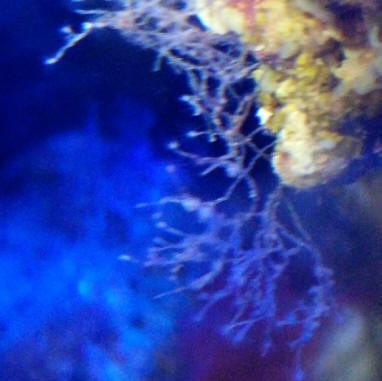 |
|
re: Can't ID hair like growth in reef aquarium (SMALLER SIZED PICS)
9/6/17
What about taking one rock out... Putting in a bucket of tank water with heater
and pump... Cover it dark for three days and see if it dies..
<Mmm; not likely to die this way; but go ahead and try it>
How long can you dark out a tank safely without killing Coral?
<Depends, but likely the corals will die at about the same rate/exposure>
Ppl do it for Bryopsis etc.. I can hammer a piece of rock that the top half has
the largest strands of this stuff.. it's a large branch rock with s large green
Monti growing from a small ledge in the middle of it.. I was thinking of
basically halving it and black it out for 3-4 days and if it kills it.
It's an algae and I should do it to my whole tank....
Your input?
<Physically systematically removing, scrubbing off (and rinsing) outside the
tank is my fave, direct approach... There are folks who advocate chemical means
of burning, sealing... There are some potential predators including Nudibranchs,
Seaslugs, Urchins, possibly fishes (e.g. dwarf angels) that might consume this
pest>
I've never had a pest issue in 2 years I always found natural remedies like
Emerald crabs or Turbo snails are sea cucumbers to keep mice and overturned or
Nassarius snails to do the same thing bristle worms to eat overfed food always
having a quarantine tank at Bay in case something happens always not being cheap
on equipment even though I'm on disability but I save my money rather than
buying cheap stuff I buy the good equipment this way it doesn't break or
electrocute me or there's all kinds of stuff that can happen but I also buy a
backup that's less expensive just in case... I just don't want to have to
somehow take my fish somewhere else to a fish store which I can't monitor mean
for all I know they could be breaking out and diseases and dying cleaning my
tank out putting my Coral in a small frag tank with an acrylic box filter and
basically scrubbing my tank with water and bleach and then scrubbing out my sump
as well..
Done cycling my tank curing my live rock which isn't going to be new dry live
rock once it's cured I have to re cure it so there's no phosphates linking or
put it in my tank fish only for a month or two while the phosphates Leach out
and then put my corals back in my tank once the phosphate start reading zero
again that's a very very long and tedious process and I would have to find a
place for all my snails crabs cucumbers pet shrimp of many sorts but I have a
quarantine tank that is medicine free I could just add a few of the bad live
rock in there to give them places
to hide and just Neil
<?>
throw some food in there once in awhile some algae Wafers some other kinds of
food just to keep him alive and sand on the bottom for my Tigertail cucumbers
one is almost 2 ft long and the other is about 10 inches and I definitely don't
want them to die them are one of my favorite things to look at when they come
out
Matthew
<Bob Fenner>
re: Can't ID hair like growth in reef aquarium (SMALLER SIZED PICS)
9/6/17
What if I remove the affected rocks couldn't I significantly lessen my biofilter
<? I wouldn't remove the rock permanently... Just to scrub/clean it. B>
|
Looking for: Lynx Nudibranch’ A.K.A Phidiana lynceus
1/13/14
HELLO FRIENDS. IM HAVING A TERRIBLE TIME WITH HYDROID DIGITA and the
lynx nudi is the BEST option THEY CONSUME THESE so I am in need of them
I have hundreds of them and they are destroying colonies and other
mother colonies. manual removal is not a practical option PLEASE HELP
ME. there's a $50.00 finders fee if you can find them . MANY people
pointed to you and your team saying that you are the BEST IN THE
BUISNESS. thank you
<I/we will post your msg. on WWM; and hold your orig. (this msg.) in
reserve... send you anyone's response. Bob Fenner>
re: Lynx Nudibranch’ A.K.A Phidiana lynceus 1/14/14
Thank you Bob and I WILL GIVE you the $50 FINDERS FEE
<No need. I would look over the SeaSlugForum, and our list of marine
vendors:
http://wetwebmedia.com/AqBizSubWebIndex/swinvertlvstk.htm
Have your dealer/stockist contact them re. BobF>
Colonial hydroid control - canned air?
3/2/13
Hello,
<Bruce>
Thank you very much for your service, this hobby is full of
well-intentioned anecdotal suggestions and assertions. I appreciate
being able to communicate with those who are smarter than me about my
silly uneducated ideas.
<Glad to help>
I am embarrassed to ask as I do not think my 'original' ideas are ever
good ones, but here goes.
I have a 120 gallon reef with coral, fish and about 100lbs or live rock
on top of a DSB spilling into a 50 gallon fuge with a DSB and skimmer. I
also have colonial hydroids in my tank all over my live rock, shame on
me, I invited them in by a period of poor tank maintenance. I have been
trying to manually remove them but the porosity of my live rock means
they come back; I think I then either need to grind a ton of rock away
or learn to live with them as they are relatively deep into my live
rock.
<Or take the rock out and let it air-dry for days, weeks>
If only there were a way to kill the hydroids yet allow the other portions
of the live rock to remain alive; if I could only freeze the hydroid
tissue without freezing the entire piece of rock. Enter the bad idea; I
know about inverting a can of dust-spray and releasing the trigger to
release the raw liquid propellant instead of allowing it to create gas
when used properly.
As the propellant, to my knowledge, is usually tetrafluoroethane
<http://en.wikipedia.org/wiki/Tetrafluoroethane > or essentially R-134a
refrigerant, I deem it to be relatively environmentally safe given that
I am only considering spraying a dozen or so spots of embedded hydroids.
Although not good for the environment I am wondering if spraying a dozen
or so spots of hydroids on various rocks from reef, rinsing the 'frozen'
rock in a bucket of saltwater then reintroducing the rock back into my
tank will result in poising the tank (I am assuming that those little
hydroid suckers can't survive the freeze)?
<I do think this method is worth trying... outdoors>
Again, I am embarrassed to ask, but I hope that it is less stupid to ask
a dumb question than to just go ahead and do it without asking!
Bruce
<Not a foolish question... Like the many discovered uses of other
products (WD-40 comes to mind) you may well have set upon a great idea
here. Bob Fenner>
colonial hydroids... Incompatibility, control... 10/30/12
Hello all,
<Howsit?>
I was hoping you could help me with a problem I am having.
<Will try>
I recently have been fighting colonial hydroids in my tank.
<Can be very trying; VERY persistent>
They have attached to all my live rock. They seem to grow into the rock
about 1/2 inch to 2 inches. I have about 90 pounds of live rock in my
tank. I have had to pull out all my rock to treat the rock. I
have been treating 15-20 pounds at a time. I treat it by using a Dremel
to cut off the hydroids
<I'd bleach them... rinse, dechlorinate, air dry>
and the section of rock they are growing from. Next, I use a
blow torch to burn the area where I had cut off.
<Wowzah!>
After that I use calk paste and apply it to the area I treated.
Following that, I apply epoxy putty.
<Come on!>
After treating the rock I place it in a quarantine tank for several
days. If it looks like the rock is clear of hydroids I would place it in
the main tank and do the process for another 15 to 20 pounds.
When I was on my last 15 to 20 pounds in quarantine, I noticed hydroids
growing on a rock in my display. It was growing out of an area that I
actually treated with the blowtorch but didn't calk or cover with epoxy
putty. I pulled the rock out burned the area, calked the area, and
covered with putty, but I put back in my display because the quarantine
still had 20 pounds of rock. After that treatment I had my protein
producing excessive amounts of liquid skim for a week 10-12 gallons of
liquid skim. Now the skimmer is working fine and the colonial hydroid
all seemed gone. Now 3 weeks later I am finding colonial hydroid again.
growing out of an area that did not have them before and was not
treated. I even found some in my sump on a pieces of ruble rock that was
buried in the deep sand bed / mud in the sump.
<Umm, yes>
Any suggestions as to my next method or step I should take?
<Yes; nuking them... bleaching as stated above... using a new
ten-fifteen pounds to re-seed the now denuded, dead rock>
I have spent way to much time trying to get rid of colonial hydroids. I
am having bad dreams about them.
<I understand>
I would like to start keeping sps corals, but I don't know how the
colonial hydroids could influence damage sps corals.
<Badly>
Thanks for your help They look like this picture from the wet web media
web site
http://www.wetwebmedia.com/Cnidarians/Hydrozoans/Hydropolyps/What-Is-This2[1]%20hydroz.JPG
Tank is 90 gallons, 4 foot long, with 20 gallon sump. It is a fish only
live rock tank with the exception of a green star polyps covering about
a 2 foot my 3 foot area of the glass of my tank.
<A portion of these can be fragged, re-introduced>
The tank has been running for 6 years. I had not been keeping up to date
with water changes, changing bulbs, 2 x 250 watt metal halide. I
recently decided to get back to keeping up with water changes, new
bulbs, cleaning tank, and checking water: salinity 1.025, ph 8, temp 78,
Alk 6, calcium 410, phosphate 0 hard to tell
with test kit, nitrate 0-5 ppm, I am fighting hair algae now I think
rock that was burnt may be curing again.
<Press on! Bob Fenner>
Colonial Hydroids from Hades (or some other dark place) coming back from
the dead
<Uhh, yes; double-posted. BobF>
colonial hydroids... Incompatibility, control follow up questions
– 12/03/12
colonial hydroids... Incompatibility, control
Hello everyone I hope things are well
<Thank you Jimmy>
I wrote last month about a problem I am having with colonial hydroids. I
am taking your advice to bleach rinse and dechlorinate my live rock, if
you can point out- or direct me to a link on how to do this procedure-
the best way to do this procedure I would appreciate your direction.
<Please see here:
http://www.wetwebmedia.com/clnornart.htm
and the linked FAQs file above>
I am moving in the next 6 months so I am not taking out live rock
to "nuke it" right now, but I will take it out when I move.
For now, the hydroid population is small but I can see it growing, so I
am not going to battle it just observe the growth. instead, I
acquired some dry live rock, from bulk reef supply, and started curing
the rock and I am planning to set up my tank with the new cured rock
that was not exposed to the colonial hydroids.
My plan is to be 100% colonial hydroid free.
<In actual practice...>
However I have a few other question: under what conditions can colonial
hydroids survive to reproduce or continue living?
<Most anything solid and wet can transport them>
What can I take from the current system and put into the next?
<W/o bleaching, air-drying... just what you can/do "net">
Can they survive in a sand bed?
<Not usually, but... possibly... I'd bleach, and/or rinse, sun-dry...>
Can they survive on my equipment:
<Some can; yes>
For example, I have a protein skimmer that has a huge colony of feather
dusters living in skimmer, can they survive in the skimmer? I have an
overflow box, jammed with feather dusters, can they survive reproduce
from the overflow? For that matter on any of my pumps, heater, or even
on or in my plumbing? I have been thinking of my tank like a
store going out of business and saying, "EVERY THING MUST GO!!!" I
am trying to get an idea of what that means.
<Not to be dismissive, or diminish your desires, but I'd not go
overboard w/ efforts to eliminate these Hydroids... Unless there of a
species,
profusion that is causing real harm... I'd go the moderate route here>
I am planning on keeping my fish, but should I try to collect and keep
other organisms from my current set up?
<I would not exclude other organisms>
Keeping in mind I don't want to take a chance of transferring the
hydroids, what could I keep? for example: I have feather dusters, I have
some very colorful ones on my live rock and even a few on my sand bed,
can or should I remove some of them? I have some snails and few
crabs can I safely add them to my new system or can the hydroids survive
on them or their shells?
<Yes; possibly>
Could I safely harvest copepods from the tank or worms?
<Yes>
I have a large colony of green star polyps can I keep the or safely sell
or trade them without spreading the hydroids?
<Yes>
Some of the green star polyps are attached to live rock some are attached
to my glass? and some are attached to my sand bed, what can I keep?
I appreciate your help with this problem. Thanks again for all
that you do here.
Jimmy
<Take some time to think over your plan... I would not go overboard in
the effort to eradicate all Hydroid/s directly.
More to be gained, enjoyed by shooting for a mix of desirable life w/
some not so desirable. Bob Fenner>
Can hyposalinity shock kill hydroids in a saltwater tank?
9/3/12
Hi there WWM crew. Hope you all are doing great. I have a 2 gallon dwarf
seahorse tank.
<A challenge to keep such small volumes stable, optimized>
I've dealt with hydroids in the past in this tank.
<No fun>
Started all from scratch some months ago. Everything has been good until
tonight when I was doing a water change and noticed the free swimming
jelly-fish like hydroids. They were like a dozen. I removed all that
were visible with a pipette and clean the Aqua Clear filter and its
media in fresh RO/DI water. Then I added some freshwater in the little
pico tank until it reached 1.017 SG. I did it as a measurement trying to
kill the leftover hydroids.
<Hope it works; but I'm doubtful. Also, maybe you'll be lucky and these
Hydroids won't turn out to be real trouble. Many species aren't>
I want to know if my attempt may be successful. What I have for life
stock is 2 dwarf seahorses, some LR that I cured previously, some
Chaeto, media bag of Purigen and 1" of sugar sand. Thanks for any help.
Frank.
<These organisms are very hard to eliminate.... best to switch out live
rock for new... air dry the olde to rid of strobilization. Bob Fenner>
|
Hydroid Help! 5/16/12
Hi Crew,
as ever, your website is a great source of information and I fear I am
re-treading old ground, but I would like to understand what's happening
in my tank.
At present, I am setting up a 55gal for seahorses; after it all cycled,
I bought some macro-algaes attached to rock to put in the tank, happily
added snails after a bit and three peppermint shrimp. I have since
been introduced to the pest that is 'hydroid' in both its forms. I
have removed the piece of rock which has the digitate hydroids,
tweezered the things off and torched them where I was able. I also
spotted a small limpet when I was doing this and am hoping it will eat
the hydroids in time.
<Mmm, doubtful, unfortunately...>
Someone said even the shrimp might. My questions are: 1) how
damaging are these critters to seahorses - specifically H. Erectus?
<Mmm, potentially? A big deal>
2) how long would I have to wait for these things to die off?
<Maybe months>
Or 3) will the jellyfish form breed and create more polyp things?
<May be different organisms... otherwise these polyps should be removed
via mechanical filtration in time>
I've attached pictures, as I may have misidentified the critters, but
I'm pretty sure they're the dread colonial hydroids and its jelly.
Thanks, Jo
<Welcome Jo... I hope they die off (don't feed, minimally light) the
aquarium... take out purposeful life and put elsewhere is what I would
do.
Bob Fenner>
|
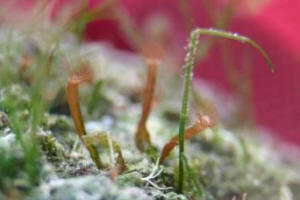
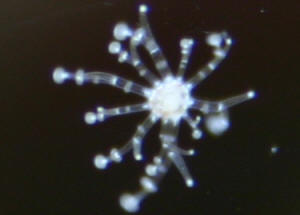 |
Need help with a "bonsai" aquarium... Pest
SW Macrophytes and hydroids 8/31/11
I'm in the process of setting up two Fluval Chi aquariums (a small
open topped 5 gallon aquarium with a centrally located
"splashdown" filter).
<Am familiar; have written reviews re these systems. Very nice in my
estimation>
One is a tiny planted freshwater tank which is causing me zero issues
and is designed to have lots of green as the central color with blues,
golds, whites and light oranges coming from the fish (a small selection
of fancy guppies, neon tetras and a Cory). This tank is irrelevant
except to show why I'm setting up my "bonsai" saltwater
tank in the color scheme and species selection.
<Ah, I see>
On one side is a plant heavy so mainly green colored, freshwater Chi
and on the other is a primarily red colored saltwater Chi with an
ominous maroon "volcano" rock play land I created by drilling
large and small holes in and gluing "volcano" rocks together
and dominated by various red macroalgaes.
During normal days there is a halogen desk lamp set up between the two
to act as a light source as the Chi has insufficient lighting for plant
and macroalgae growth out of the box and is replaced with a Japanese
flower vase when entertaining friends.
<Sounds/reads nice>
My freshwater tank has relatively active and frisky small fish. To
showcase the contrast, the only finned friend I'm planning on
housing in the marine bonsai tank are dwarf seahorses (Hippocampus
zosterae).
Although the freshwater tank has been up and running for five months or
thereabouts, I have held off on adding the ponies until I felt the tank
had appropriately matured.
<Good>
I currently have everything I plan on adding except the seahorses up
and running but recently found two hitchhikers I find troubling.
Currently in the tank I have two species of red sea grape
(Botryocladia), two species of red Gracilaria, one Nemastoma and one
Dragon's Tongue (Halymenia). For cleanup crew and to complete the
"bonsai look", I have a number of Nassarius snails,
"dwarf Ceriths" of unknown species and wide color morphs sold
from a diver in the Florida Keys that will supposedly stay under a half
inch (so far the biggest is a quarter inch), one or more species of
Asterina starfish plucked from my coral reef, and some random micro
brittle starfish removed from the same.
<Mmm, okay... t'were it mine, I'd simply keep physically
trimming (while siphoning) the pest/undesired Macrophytes away.
BobF>
Need help with a "bonsai" aquarium
8/31/11
I currently have everything I plan on adding except the seahorses up
and running but recently found two hitchhikers I find troubling.
Currently in the tank I have two species of red sea grape
(Botryocladia), two species of red Gracilaria, one Nemastoma and one
Dragon's Tongue (Halymenia). For cleanup crew and to complete the
"bonsai look", I have a number of Nassarius snails,
"dwarf Ceriths" of unknown species and wide color morphs sold
from a diver in the Florida Keys that will supposedly stay under a half
inch (so far the biggest is a quarter inch), one or more species of
Asterina starfish plucked from my coral reef, and some random micro
brittle starfish removed from the same. I also have a large number of
Opae Ula/Red Volcano Shrimps (Halocaridina rubra) and massive numbers
of pods in all shapes and sizes.
<Okay>
The problem and question is this, everything is fat, healthy and
breeding so I feel like in general I'm ready for the dwarf
seahorses, BUT I have two very active predatory cnidarians of some sort
that hitchhiked their way in despite my best efforts at freshwater dips
and quarantine time. I know what you really want is a picture, but
I've been unable to take one of either creature that does a decent
enough job to be better than the verbal description as they are both
small and 99% transparent. I assume they are hydroids but do not let
that color your interpretation. Either way, they are very active
predators of my pods and it scares me about what could happen once I
introduce dwarf seahorses and more importantly their food source of
BBS/baby brine shrimp.
<Mmm>
The first is almost impossibly long for its tiny size, stretching
upwards of maybe five inches at maximum. What it looks like is a tiny
(about half the size of a bb shot, maybe a quarter) perfectly round
transparent ball with tiny tentacles sparsely decorating its entire
circumference connected by an incredibly thin but very long tube to my
red sea grapes. It can relatively swiftly retract up and down this thin
tube in order to hunt down and capture free-swimming small pods.
It's really quite fascinating to watch as the "ball" zips
up and down with the relatively quick retracting "tube".
The other concern is a hitchhiker that has no other discernible body
parts than a similarly thin whip or rope. It is similarly anchored to
the macroalgae but rather than having a ball chasing the pods, it stays
mostly retracted and when one gets within striking distance (an inch or
two at maximum) it whips out at super quick speed to snag the pod. The
first is amazing because it's Cnidarian of some sort (I assume)
that is stalking and hunting it's prey, the other is fascinating
because it must somehow "see" the pods and get triggered out
to seize them at an eye blink.
<Do seem like Hydrozoans, Hydroids>
As the BBS are about the same size as the pods these two bizarre
creatures are eating, I'm concerned there might be a population
explosion (right now there are about six of the first and four of the
second that I've found).
Dwarf Seahorse keepers are terrified of just colonial hydroids and now
I have two things 100 times more active in their predation. I'm
tempted to use Panacur, but that will definitely kill the dwarf Ceriths
and probably lots of other beneficial things in the tank. What is your
suggestion?
<Remove the infested rock/s and scrub thoroughly w/ a stiff
toothbrush, rinse thoroughly in fresh water...>
Add the dwarves and see what happens? Use the Panacur H-bomb? Reboot
the tank entirely?
<Remove the Hydroids first. Oh, and read here: http://wetwebmedia.com/marine/inverts/CnidIndex1.htm
Bob Fenner>
Re: Need help with a "bonsai" aquarium 8/31/11
Thank you very much for the advice!
<Certainly welcome. BobF>
|
hydroids... control
6/29/11
I've had both digitate and colonial hydroids in my 29 gallon
mini-reef tank for over a year. The colonial hydroids,
especially, have grown over much of the rockwork (see attached
pic of Zoanthids/Palythoas engulfed by hydroids).
<Aye yi yi... no fun>
Nutrients are controlled as best as possible (biweekly water
changes, limited feeding of livestock), yet the hydroids remain
unaffected. Eradication seems impossible without replacing all
rock/sand. The hydroids didn't appear during the first year
or more that this tank was running. I know they can enter a
system via live rock, coral frags, etc., but my question is this:
Is any particular type of live rock (for instance, Fiji rock vs.
Caribbean/Florida aquacultured rock) more or less likely to
harbor these pests?
<Not as far as I'm aware>
Secondly, if an unseen hydroid is somehow attached to a new coral
frag or its plug, is there a dip that will kill the hydroid
without also impacting the coral, quarantine notwithstanding?
<There is none I know of. Bob Fenner>
|
|
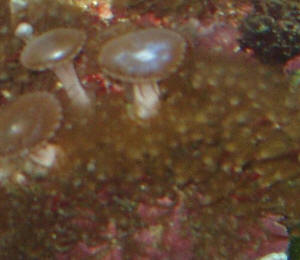
|
|
Micro-invert ID 6/28/2011
Good afternoon, crew,
<Dan>
I have just recently seen several of these little dudes in my
'fuge. I have searched to the darkest end of the web (may
have missed a spot or two), and am clueless. Although I have NO
idea what they are, they are fascinating little creatures. The
"tail" appendage telescopes from about 5mm to 50mm and
retracts again, leading me to believe it is a feeder arm of some
sort. The main body is about 2-3 MM in length.
Can you give me a vector, Victor?
<I do think you have a Hydrozoan/Hydropolyp species here...
I'd vacuum these out. Stinging if they get into your main
system and eating you refugium production where presently
encamped. Bob Fenner>
Dan
|
|
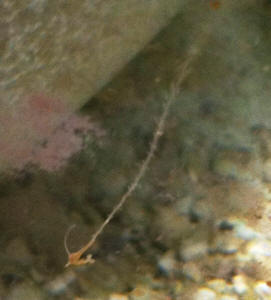
|
Re: Micro-invert ID
6/28/2011
Thank you. Since my email, I've counted at least 10 so far in
my fuge.
Going to be fun getting them all out of my Chaetomorpha!
<Might I suggest a bit of rigid airline tubing attached to the
airline as a siphon? BobF>
Re: Micro-invert ID 6/28/2011
Exactly the set-up I used to siphon off the red-brown Planaria that
went nuts in my tank earlier. Works very well. I'm a bit more
concerned about actually finding all the little freaks hidden in
the Chaeto. Maybe remove and rinse it all?
<Worth trying. B> |
|
Hydroid Jellyfish swarming 5/18/11
Hello WWM Crew!
I've a problem that I've been able to identify by looking
on your fantastic site, but mine seems no sign of abating.
<Oh oh>
I've a small 6 gallon Fluval EDGE tank (My first Marine tank)
that I've converted into a Pico Reef,
<VERY hard to keep such small systems successfully for
long>
I've had it running two months, cycled with LR and it's
doing wonderfully.
Currently it's stocked with a Briareum Sp. Star Polyp colony,
a small green Zoa colony, and a pimply brown Mushie for corals,
and livestock is one Yellow Clown Goby, happily feeding on flakes
and frozen shrimp, a cleaner shrimp, one Nassarius snail, one
Turbo snail and a Dwarf Blue Hermit crab.
I've had no problems with the tank so far in regards to the
various baddies that can possibly come in on LR, the tank cycled
perfectly and my parameters are spot on. However, from about one
month in, I noticed small shapes appearing on my glass, that
looking through your site I identified as Hydroid Jellyfish
(Staurocladia oahuensis). I spotted the piece of LR that had a
few white digitate Hydroid polyps on and gave it a scrub to rid
it of them,
<Good>
but I think the larvae are still multiplying like rabbits.
There's some on my glass that I catch now and then with the
algae magnet (I have to do this daily), but on the glass portion
of my heater, there are literally HUNDREDS of the things.
<Wipe them off, with a paper towel (out of the water, heater
unplugged>
I know from looking on your site that these can all appear, and
randomly disappear as quickly, but I've had these things in
my tank for a month, and with it being so small if it gets worse
I fear they might start stinging everything else. Is there any
way to remove them safely without damaging any other
livestock?
<Mmm, well, at times, yes... a mechanical filter (like a toned
down Diatom (tm) can/will filter out the Polypoid forms
expediently>
Also, one other question, my green Zoa colony was doing fine, but
over the last few days shut up after it 'had a poo', and
has only just started to open, but the polyps won't open
fully. Is this normal, and will they open fully soon?
<Can't tell from the info. provided. May be
"nothing", to some sort of chemical imbalance,
allelopathy... You'd do well to scan WWM: http://wetwebmedia.com/mntsmmarsysf6.htm
and the linked files above...>
Thank you in advance,
Adam
<Welcome in time. Bob Fenner> Re: Hydroid
Jellyfish swarming 5/18/11
Hello again Bob/WWM crew!
<Adam>
I thought I'd send on another mail in regards to my small
setup, after being pointed to your small aquaria section (Another
bit I didn't know existed, thanks Bob!) about running and
keeping these things.
As I put before, it's a Fluval EDGE tank with some upgrades,
mainly the lighting. It's currently running under two MR16
LEDs, at about 5000k light-wise. This weekend however, I'm
changing it to incorporate a TMC Aquabeam 600 LED bar, Reef White
colour (Five Cree LEDs in all, three white, two blue). I've
also changed the filter media, running filter floss, Polyfilter
and some Sera Siporax media balls.
<Good changes, additions>
It's got a Koralia Nano for water movement, directed at the
back and towards the surface of the water, so it doesn't
blast everything about and helps with aeration, and it's got
a Hydor Theo 25w heater.
In my last post I also mentioned the livestock (Currently
it's stocked with a Briareium Sp. Star Polyp colony, a small
green Zoa colony, and a pimply brown Mushie for corals, and
livestock is one Yellow Clown Goby, happily feeding on flakes and
frozen shrimp, a cleaner shrimp, one Nassarius snail, one Turbo
snail and a Dwarf Blue Hermit crab.) The Goby's been doing
well and is eating happily, and both the Cleaner and the Hermit
have both molted once.
My query is to what I can do that will improve more quality of
life in the system. I knew from doing my research before the tank
it would be difficult to look after, but I was prepared to go
through with it, as I don't have room for a bigger tank at
the moment. As for maintenance, I check the parameters every day,
(so far so good) and I perform a 10% water change every week, and
any supplemental if I see parameters swing a little. The Goby
(after I got him eating) and the Shrimp both seem to be doing
fine on flake and frozen/live enriched Brine Shrimp (I'm
going to stop the Brine for a while, as it turns out my
previously mentioned Hydroid problem thrive on the shrimp)
What do you reckon to the lighting upgrade I have planned?
<Is a good one. Am familiar w/ the TMC LED line... have penned
an article re a small sys. w/ these... just last week>
My intention was to get the new lights for coral growth/better
life, and then probably try a small hard coral frag (A torch,
most likely) and then the last things I'd like to add are
probably a few more corals - softies most likely -
<Do take care to "acclimate" all new Cnidarians...
I'd place the Euphyllia/s last...>
a small tank-raised clown - obviously provided I make sure I stay
on top of everything. I'd just like another opinion on how it
might run given time and proper care.
<Could work>
In any case, here's a couple shots of the tank for you, and
the Clown Goby hosting the Briareium :)
<Ah, nice>
Thanks for the help, and an awesome site
<The small "squiggly" white spirals evident on the
LR behind the Hippolytid Shrimp... these are not what you
are/were referring to as Hydroids? They're serpulid/spirorbid
worms. BobF>
|
|
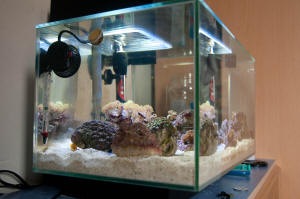 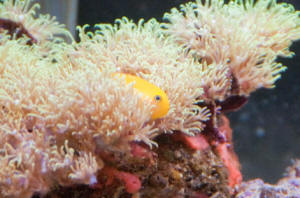
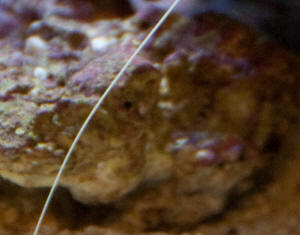
|
Myrionema? Nausithoe? I just want it gone!...
Scyphozoan contr. 10/6/10
I have several rapidly reproducing colonies of some creature I cannot
identify. Each colony member has a flexible tube that it retreats
into.
The tube is a clear yellowish color and the mouth of the creature stays
very close to the opening of the tube, with about a dozen fluorescent
green threads <1/2" long radiating from the mouth. The tubes
vary in length but seem to max out at about an inch long (at least in
my tank)
<And you suspect...>
What makes me think this is not Myrionema is that it's not brown,
and it hasn't stung anything ever that I can tell, it grows
side-by-side with corals and I've never had a reason to hate it,
except that it's EVERYWHERE and spreading. It's a nuisance just
based on it's ability to populate.
<I see>
What makes me not at all believe that this is Nausithoe sp. is that
would just simply be too good to be true...and when I get a wild hare
and tear out colonies, they appear to sprout back from whatever I
wasn't able to remove from the rock. That doesn't sound like
any jellyfish I know.
<Mmm, could be>
I've included a link to someone else's picture that looks
exactly like what the creature/colony I have in my tank is - I mean to
the T. He's got it "identified" but I just can't see
how that's right.
Good news would be appreciated, but I'm ready for the worst.
Here's the pic:
http://www.masa.asn.au/phpBB3/viewtopic.php?f=53&t=221761
<Mmm, well... this pic does seem to be of Nausithoe racemosa... I
don't know re control, specific predators... at the worst, you may
have to remove, break off all wanted life, nuke (bleach...) the rock...
start with some new... Bob Fenner>
Thanks in advance!
Red
|
DIGITATE HYDROIDS 7/6/10
Dear WWM crew,
<Hi there Bill>
Lately I've been seeing these little things in my tank,
mostly on my refugium (in the sponge) see pic below
They look almost transparent and if you magnify the pic 200%,
you'll see that they are kind of spiny (3rd pic).
I was told that they are DIGITATE HYDROIDS, is that correct?
<Might well be>:
Are these things harmful to fish?
<Mmm, well, they can be... in large numbers...>
I have no corals in my tank, just a FOWLR tank.
If so, how can I get rid of them? My tank is in it's 4th week
of going fallow.
Thanks,
Bill
<Most often such organisms are "transitional" in new
set-ups... in other words, they most often "go" of
their own accord. I would not do anything overt at this juncture.
Please read here for more:
http://wetwebmedia.com/hyzoancompfaq.htm
and the linked files above. Bob Fenner>
|
[1]%20hyd.jpg) |
Invertebrates... Hydrozoan (?) control, hermit crab
parasite/symbiont? 7/2/10
What's up? I love the site.
<Well okay!>
I have a question about something in my tank... I got about a pound of
LR a few days after I set up my tank and I noticed this stuff on one of
the small rocks; it looked like maybe a "hair algae" to me -
I hadn't done any research about algae or LR at this point. I
didn't think anything of it.
When I got my 2 blue-legged & 1 red-legged hermits the red-legged
hermit ate it off the rock. It's pom-pom-shaped and each
"strip?" has a tip like a "Hydrozoan." Which each
move independently, so I know it isn't an algae, but some kind of
animal. The thing is they're multiplying all over the panes of
glass where the red-legged hermit can't get to them. Now after
getting a tiny hint of info I've scraped them off the glass and
tried sucking out as much of them as I can with a turkey baster, but is
there anything else that will eat them? ...off the glass.
<Not likely, no. You may have some "luck" with time going
by... their dying off for whatever reason/s. Read here:
http://wetwebmedia.com/hyzoancompfaq.htm>
Also, I'd like to know some advice about a boring worm in my
red-legged hermit crab.. there are two, one smaller than the other.
Should I try to extract them? Can you tell me how?
<Maybe, with tweezers...>
I haven't been able to find much info on the net at all, except
that they eat hermit crab eggs. It's supposedly a symbiosi? How do
the hermit crabs benefit from them?
<Sounds more like space "parasites"... in some
classification schemes for Symbioses, there are classes of
parasitism... where the symbiont gains at the expense of their hosts...
Bob Fenner>
Hydroid Myrionema 01/20/09 Hi Crew, <Aloha
Clay> I have a problem with what I believe are hydroids (myrionema)
and would like to get your advice. The photos that I have seen online
appear to match what is in my 90 gallon reef tank. There are 4 or 5
small patches on a large rock that is a little larger than a football.
The rock is located on top of 2 equally large rocks forming a cave so
it would be easy to pull. I have not observed the hydroids on any other
rock. From research on your site and others, the options for
controlling or killing these are not great. Since the rock is easily
removed, should I just pull the rock from the tank to prevent further
spread? <This is one option. But it's an extreme one. If it were
me, I would take the rock out and use a Dremel saw (or a screw driver
and a hammer) to chisel off the parts of the rock with the hydroids.
Then rinse the rock off very well with salt water (preferably from your
tank-- you could even do a water change at the same time). You
can't just scrub them off or else they'll grow back. And if you
don't rinse the rock really well, some fragments of the hydroids
might remain and grow back.> I have 2 nice leathers attached to it
that I can frag and salvage. However, there is very nice GSP colony
that I fear will be lost since one of the hydroid colonies has begun to
overgrow it. If I remove the rock, what damage will this do to my
biological filtration? The rock represents probably 15-20 percent of my
total rock. The tank is 1.5 years old and I haven't added anything
for 6 months so I am not sure how they got into the tank. Can these
creatures lie dormant in the rock for long periods? Any advice you can
provide would be greatly appreciated. <Do try the method described
above-- might spare your rock and your corals. ;-)> Thanks, Clay
<De nada, Sara M.>
Digitate Hydroids. Danger? Control? 11/29/08
Hello WWM Crew. I recently added some Live Rock into my tank and
noticed that i have a few Digitate Hydroids. I have searched the
internet to find out about them and i have read that these give a nasty
sting to corals. <That's not always true. It depends on the type
of coral and the type of hydroids. Some hydroids are harmless.>
Several other websites have advised to get rid of these as soon as
possible, several different methods have been mentioned, including
Kalkwasser Paste, Injecting with Vinegar. The problem i have is that
the piece of Live Rock they are on is full of Polyps and i do not want
to kill these. <Are you sure the hydroids are stinging your coral?
You should be able to see signs of this on the corals. It will look as
if they've been "burned" or they will be closed up around
the hydroids. If you don't notice any obvious signs that the
hydroids are stinging the coral, I wouldn't risk doing more harm
than good by trying to kill them.> Some other sites have said that
these creatures thrive on high nitrates and phosphates and therefore
when my tank has gone through the cycle that these will just die, is
this true? <This is a possibility. In any case, theses kinds of
animals usually come in waves and will likely die off on their own
eventually.> I can't seem to find much information on these, if
they are so bad, surely there would be more information out there?.
<I wouldn't worry about them unless you can see that they're
doing damage.> Thank you for taking the time to read this, and any
help or advice will be appreciated. Kind Regards Jo <De nada, Sara
M.>
Re: Digitate Hydroids attn Sara 12/02/08
Thank you kindly for your response. 12/01/08 The only reason i noticed
the hydroids is because the polyps were all shriveled and grey and
never opened, <Oh, that's no good.> which makes me think that
these hydroids have killed them. I don't really know what to do
next, I have been told that the hydroids can multiply and take over. I
am not sure about adding any corals now, as I do not want to kill them.
<Unfortunately, if the hydroids are growing right up against your
corals, I don't know what you could do to kill them that
wouldn't also hurt the coral. What kind of polyps are the coral? If
they are soft corals, you could try removing the coral from the
rock...> Any advice would be appreciated <Reducing nutrients and
pollutants in your system is always a good thing... so if there are
ways you can do this, it can't hurt.> Thanks Jo <Best, Sara
M.>
Hydroids: growing problem..., control
11/29/08 Hi there! I am about to give up my fight against
brown hydroids. Read some nice article on how to kill them with calcium
hydroxide paste (Kalk) but it doesn't work. Tried brushing and even
crushing a layer of LR surface (a few millimeters at least) with coral
cutters. Nothing works. <One "last" thing you can try is
NaOH mixed with Kalk. See here:
http://www.asira.org/killingaiptasiaxeniaetc > They seem to borrow
in the rock and retract several millimeters within the LR. I read that
Berghia Nudibranch are useless against them. I also just read that
limpets, and possibly keyhole limpets in particular, could eat them. Is
it really worth a try? <I don't see why not. I'd try to get
as many as possible of them with the NaOH... then maybe see if the
limpets can help keep them from coming back.> What specific limpet
species should I use to try eradicate the brown hydroids? <I
honestly don't know... but these critters will vary from individual
to individual (not merely from species to species). I would suggest you
ask Morgan Lidster at Inland aquatics. If anyone would know, he would.
http://www.inlandaquatics.com/> Otherwise the only other option I
see is changing all my LR, but that is quite an expense and a lot of
trouble and in the end there could be a few left somewhere under a
coral (even as a medusa...). <Oh no... don't do that! Try these
other things first. If all else fails, I suggest giving up. Seriously,
in my experience, sometimes giving up sometimes works eventually.
;-)> Thanks for your advice! Dominique <Best, Sara
M.>
Re: Hydroids: growing problem... 11/29/08
Thanks a lot for the NaOH tip. Will try it soon (will talk to the
pharmacist -who knows- otherwise will order from Fisher sc.). <Oh,
no need to speak to a pharmacist... just look for "Red Devil"
drain cleaner... it is, more or less, pure NaOH. I get mine on eBay.
http://shop.ebay.com/_W0QQ_nkwZredQ20devilQ20lye Just... again, as the
site says, be VERY careful with it. It DOES burn.> Very interesting
site too Asira.com, didn't know it. <Thanks... is my own
personal creation. ;-)> And for the limpets I already sent an e-mail
to Morgan Lidster. <Ah, good... he is one of the "best kept
secrets" in our hobby... likely more knowledgeable than any of us
here, save Mr. Fenner. But unfortunately, he is a bit of a recluse. If
you ever go to a MACNA, I highly suggest you seek him out... just be
sure to carry a good bottle scotch with you (his weakness
apparently).><<Heeeee! You DO know Morg! RMF>> Thanks
again! Dominique <De nada, Sara M.>
Re: Hydroids: growing problem... 12/03/08 Hi!
Does Sodium hydroxide precipitate Phosphate (like Calcium hydroxide
[Kalk] does)? <Good question... I imagine that it does to some
extent and for some phosphate. But I certainly wouldn't use it for
that.> Thanks! <Best,
Sara M.>
|
Hydroid, ID, control... 11/14/08 Hello all!
<Mariusz> I was hoping you could give me an ID (ie.
scientific/common name) on this Hydroid. It was taken from:
http://www.wetwebmedia.com/hyzoanidfaq.htm (i have also attached
the same pic). I have a bunch of these in 120 tank with about
140lbs of live rock. <Mmmm... can't tell the species from
this small pic> I recently took all fish out of the tank to
let run fallow after a parasitic infest. Most corals have been
removed (for other reasons). All that is left are a few mushrooms
and leathers, peppermint shrimp, hermits. The tank has been
running fallow for 6 weeks now and I'm in no rush to put my
livestock back in. Also for 6 weeks I haven't put any food in
the tank either, it's just been running with Deltec skimmer
(which hasn't produced much as I have almost no livestock and
no feeding). So questions: 1) are these hydroids a danger to
fish? not sure how potent the sting is. <Could be... if
they're unaware, get too much exposure> 2) How can I rid
these with out manual removal as I've been trying for almost
a year. Not sure if these guys are worms of some sort and if
de-wormer will work, possibly Prazi or other. Is there any
biological alternative? Without proper ID its been difficult
moving forward towards a solution. Thanks <Can be very
difficult... frustrating up to the point, extreme, of making it
reasonable to bleach/kill all LR, start over with some new LR
material placed over, amongst, using the killed rock as base...
Otherwise, you might be lucky to discover a predator (perhaps an
Opistobranch...), but even here, they wouldn't eliminate
all... "So many chickens, so many foxes"... Bob Fenner,
who would bleach, nuke>
|
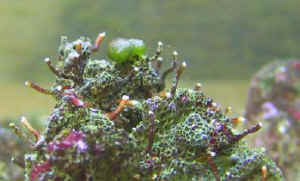 |
|
Re: Specific tank questions... Hydroid contr. -- 07/14/08
What would a LFS do with the rock with hydroids? Just wondering.
Matthew Harless <Mmm, a few approaches to control... nutrient
limitation, predation, poisons... Read here:
http://wetwebmedia.com/hyzoancompfaq.htm BobF>
Re: Specific tank questions I'm sorry I meant why
would they want to take them from me? You suggested that I
sell/trade the hydroid infested rock to a dealer and I was just
curious why they would want it. Not an important question, I was
just curious. Matthew Harless <Mmm, that profit motive
thing... "One persons noisome Mushrooms is another persons
income"...the future belongs to commerce. B> Re:
Specific tank questions I misunderstood. I thought you meant
to sell them the brown hydroids (myrionema), but you were talking
about the Corallimorphs. Thanks for the clarification. Matthew
Harless <Ahh! Thank you. B>
|
Hydroids, control -- 6/4/08 Hello again
Crew, <Hello> After a hair algae explosion, I now have an
explosion of hydroids (see pic below). <No picture
attached'¦> They are covering all of the surfaces inside
the aquarium and sump. I don't mind them because they are simply
demonstrating the "fertility" of my aquarium. <Rather the
polluted state. Plague levels of a single organism are never signs of a
healthy ecosystem; biodiversity is the key.> They're very small,
so should I be worried about them stinging? <Yes. Many hydroids pack
a wallop.> Will my snails and/or hermit crabs eat them and/or the
hair algae? <No. Careful control of nutrient, overfeeding, etc. will
thin the herd.> Well, I have to catch the bus. Thanks in Advance,
<Welcome> Random Aquarist <Specific Benjamin>
|
Help with Hydroid myrionema. - 04/14/08 Hello Again. I
believer you are correct on what i have (hydroid myrionema). We
have a hard time getting rid of it. <Yes... can be a real
bugger> I have searched on line for remedies. With my tank
being 200 gal. reef safe with the following (blue tang/unicorn
tang/clown tang/2 yellow tangs/cleaner wrasse/Lunare wrasse/blue
damsel/Banggai cardinal/pajama cardinal/blood red Hawkfish and a
mated pair of green mandarin gobies) a clean up crew and we have
feather dusters/tube anemones/polyps/frogspawn/leather corral and
mushrooms. We do water changes for nitrate levels, and have
decided to move to the Zeo system. However i wanted to know what
this Panacur is all about. On line people have used it to get rid
of the hydroids, but does it work, and will it help me. Thanks MC
<Mmmm, what are the active ingredients in this product? Bob
Fenner.
Re: Help with Hydroid myrionema. 4/16/08 April 15, 2008
Hi again. I'm sorry the product people are using to get rid
of Hydroid Myrionema is Panacur, the main active ingredients is
Fenbendazole. <Ahh!> I wanted to know if i could use it?
<Mmm, well... it may well kill off a good deal of the
"wormy" life in the system... is an anthelmintic... and
most all marine systems, natural and aquarium have substantial
worm faunas... So, at the least I'd have a good deal of
pre-made water ready, be aware that changes may need to be
made... successively, along with the use of chemical filtrants,
change of mechanical media, cleaning of skimmer/s...> But I
wanted to make sure i don't kill off my tank. <You are
wise here> What do you suggest? I'm at my wits end with
this hydroid, (working on it for over 9 months) and if it
weren't for my mated pair of green mandarin gobies, which are
doing very well, i would kill of my rock and start over.
<Mmm... I would try some biological controls first myself...
or move all the "desired" livestock elsewhere for a few
weeks, while using the "de-wormer". BobF>
|
Hydroid jellyfish -01/29/2008 Hi, I have a
lot of these in my tank glass. I try to use the magnet cleaner to
scrape these off, but their number never seems to reduce. Is there a
way to remove these from the tank? Thanks in advance. <Patience and
time work best. These things typically have population boom and bust
cycles. You can help things along by scraping them off with a razor
blade (if a glass tank), and suck them up with a water change.>
Regards, Kash <Best,
| Hydro ID and help -- 1/04/08 Hi guys, Thanks
for maintaining such a wonderful site. I have been visiting this
site for over 4 years now and have always found to be a great
source of information. I need a little help though, and would
appreciate it if you guys could give me a hand. <Will gladly
render my input> I'm looking for a positive ID on this
little critter (see attached). After exhausting all resources here
at WWM on Hydrozoans, I went looking for better classifications of
these guys and I found a great site for identification:
http://www.ville-ge.ch/mhng/hydrozoa/hydrozoa-directory.htm. I
think I've come to the conclusion that this is probably Class
Hydrozoa, Order leptomedusae Family Malagazziidae <Appears so to
me as well> I only see them in the Hydroid colony stage.
Hopefully I'll never see the medusa stage ;) <Is, will be
there in time... likely being removed by your mechanical
filtration> Anyhow, looking through the articles at WWM I'm
trying to find out how to really get rid of these guys. Everything
I've seen at WWM says starve them out and remove the nutrient
rich environment. My question then becomes "what
nutrients?" <In boldest statement of what can be easily
measured, soluble nitrate, phosphate...> What do these guys
depend on to grow? <Mmm... some chemical base, micro-fauna... a
dearth of predators, competitors> Although, the appearance of
these things seem to correlate with my use of Koralle-VM from
Brightwell Aquatics. I have since changed to Coral-Vital from Marc
Weiss Companies, Inc to see if it will have a different effect.
<I would drop this Weiss product... and most all of its ilk>
They also seem to be accompanied by this brown looking mush on the
live rock. I have an 11 Gal Aqua-via tank, with an Aqua C remora
Protein skimmer with Maxi Jet 1200, 25lbs LR and a 3in sand bed. I
only have a couple of zoo's and a single clown fish. Not really
much of a bio-load here. The Aqua C should be more than enough of a
protein skimmer for this tank/load. Any ideas on how to starve
these guys out? Any specifics would be greatly appreciated. Thanks,
Jas <Mmm... well... I might try a small shrimp (or two)...
perhaps Lysmata wurdemanni... in the hopes of them eating up the
hydroids. Bob Fenner> |
|
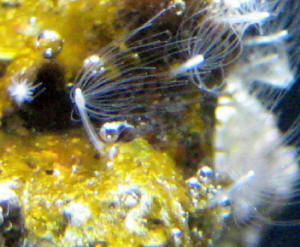
|
|
Digitate Hydroids, contr. 10/3/07 I have 20+ Digitate
Hydroids in my 29 gallon reef tank. The population is getting to
a point where the numbers are starting to worry me. I've had
a population explosion of them over the past month. Most
disturbing is that this month has been the most solid on
husbandry for the tank as well. The tank is about 6 months old,
has weekly 20% water changes and is skimmed fairly heavily. They
are really a concern because I have had corals affected by them,
and have actually had some tissue loss due to the them as well.
<Not good> Manual removal is extremely difficult for most
because of placement. Kalkwasser injection is also very difficult
because some of these guys are really small. I've superglued
over them; used tweezers on them; attempted to Kalk smother them.
I've dealt with pests, but I'm completely at a loss at
ridding the tank of these guys. Searching the internet high and
low I have found little in the way of tried and true
recommendations. I've read the population can wane with
nutrient control, but in no way do I consider my tank nutrient
rich. Do they have a natural predator? <A few... but these can
be very species specific...> Is there a treatment? <Mmm,
not ones that are very satisfying... removing the rock... letting
it dry... to kill off...> I'm worried that if I don't
get this under control and the population continues growing that
I may need to start at square one again. Regards, Jarred in
Portland, OR <A pic please (close-up, well-resolved)... and
where did the rock originate (which sea, island group?)... Bob
Fenner>
Re: Digitate Hydroids, contr. 1/20/08 Unfortunately,
I'm not sure where the rock is from. Somewhere in the Pacific
I believe. <Okay> Attached the best picture I could get of
one of the digitate hydroids. This one is dead, but when alive
they look thread-like like most of the pictures you'd see on
the net. Thank you! <Mmm, I would try removing all these...
manually... take the rock out, systematically scrub, scrape all
off at the base... rinse... replace the rock in the tank. Hope.
Bob Fenner>
|
|
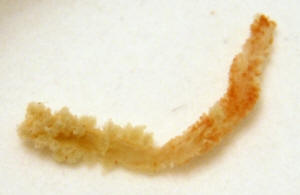
|
Stinging Hydroids HELP w/ pred. control - 4/7/07 Once
again I'm back for expert advice.. <Okay> I've done some
extensive reading on stinging hydroids on your site. In fact, I've
found my pests picture here http://www.wetwebmedia.com/hyzoanidfaq.htm Article: Bad boyz-
hydroids 12/30/03 You've mentioned in other articles that these
have few reef safe predators. <Yes... though these are often quite
"species specific"> What would the predators be of the
"tube like coiled at the base" string hydroids ? Nudibranch
is one critter that keeps coming up. <Some species... definitely not
many/all> I have sooo many at this point, scraping them off would
take forever. Thanks, Chris <Well... the path may be long here...
and not one I would take... experimenting blindly... If you want to go
this predator route, FIRST (dang, that's bright), you should
determine as closely as practical, which species of Hydroid you have...
will require the use of reference works, a microscope likely... I'd
try writing some folks on the Net who work in the field of taxonomy,
biology of the Hydrozoans for suggestions here... Bob
Fenner>
Re: Starfish and Hydroids? Blue Linckia
(Linckia laevigata) Better Left in the Sea. 2/9/07 <Hello
again Travis!> Thanks for the great info, Mich! I'll avoid the
blue Linckia star! <Very good!> Follow-up question: <Sure.>
Would any/all starfish be damaged/irritated by crawling over rocks
covered in hydroids? <Yes, it is possible.> i.e. If my rocks are
mostly covered in hydroids, do I have to rid my tank of them before I
could add any (non-sand-dwelling) starfish? <Mmm, no, but again not
for the reasons you state. I am hesitant to recommend any starfish that
are of the "rock scrubbing" type which I believe you are
considering. Most just don't do well. Serpent and brittle stars
should be fine. I wouldn't recommend the sand sifting star either,
as it will take out much of the beneficial fauna in the sand bed and
then starve. Hope that helps! -Mich> Travis. Hydroid
control? 1/27/07 Hello...this is Stephanie. <Hi, Stephanie!
GrahamT here.> I am new to nano reefing. <Welcome to the world of
micro.> I have been reading about hydroid problems with zooanthids,
unfortunately, we were too late in saving it. It smelled pretty bad and
didn't look to good. <Unfortunate... sorry for that.> But, my
question....could this problem have spread to our hairy mushroom?
<If you mean, can it spread nearby and sting, yep. If you mean can
it infest the mushroom, then I have to say I'm not familiar with
them moving about. I am somewhat inexperienced in the hydroid
"field" but in my research ( http://www.wetwebmedia.com/hydrozoans.htm and all links...)I
learned that they need somewhat higher concentrations of nutrient to
thrive. Also, they are usually "fixed" to the rock.> It
looks good but has a few areas that look similar to the zoanthid.
<Am I missing a past email? What did the Zoo look like?> Please
help..... <Trying... -GrahamT>
Hydroid control? <follow-up> 1/28/07 Thank you
for the quick response, Graham T. <Welcome, though not immensely
helpful, I suppose.> I made an error when I put Zoanthid, I should
have put hydroid. The patch on the mushroom, or I should say on the
rock is grayish and looks velvety. The other spot on the Zoo was
actually "moving" little things you could barely see. So,
somewhat different but I am worried I will miss this and then it will
be too late. <I want to be sure not to mis-diagnose. Is there a
chance you could send a pic (under 400K) so I can get a look at the
critter?> OR.....could this be fungus? The rest of my life rock
doesn't show any areas like this one. Overreacting or playing it
safe? <Always playing it safe... -GrahamT.> Thanks
Steph
Hydroids infesting my Zoanthids? Dear Crew,
<Russell> Here's a new one for me...maybe you also? <Could
be> Over the holidays my Zoa's (four frags, about six months old
and previously healthy) closed up and became infested with little
critters. My Ca and dKH dipped mildly when I was out of town for three
days, but otherwise the tank was stable.. (need to get a calcium
reactor, my 2-part dosing pump is temperamental). These parasite-like
things attach to the closed polyps and are too small to photograph
accurately. They look like a small (1-3mm) hydroid-ish creatures,
having a clear stalk with small white-brown tentacles. They start like
white little dots and grow pretty fast, spreading to all colonies and
show tiny tentacles. I had hydroids on my tank walls last year, but
they went away after a month or so. <Typical> Last week I removed
the frags (some had already grown on to surrounding rocks) and did a 15
minute dip in a gallon of tank water with a salinity of 1.015 and over
a tablespoon of Lugol's... at the same time blasting the frags with
a turkey baster. This seemed to do the trick upon reintroduction...
most polyps re-opening and looking good. <Good> Then, over the
last two days, the little critters came back so last night I re-dipped
the frags- same as above except for 30 minutes AND I followed this with
a flash RO/DI water dip. I also pruned and discarded the remaining
small amount of new growth- polyps left behind on my LR (figuring these
small stragglers were still infected and causing the problem).
<Mmm... much more likely to be residual animals in your system...
really need to dip, move the Zoanthids to another setting> This
morning the frags, for the most part, are open with no obvious
critters. Could these be hydroids?? <Oh yes> I've searched
this site (and others) and am confident it is not "reef pox"
which is more pustular, ulcerative in nature. If these apparent
parasites come back, any other ideas???? <Mmm, plenty>
Interestingly, I also recently picked three Nudibranchs off the Zoa
frags. I don't think the infestation is from Nudi eggs. Also, they
are not Zoa spiders. Thanks, Russell in KY <Hopefully gone for good
this time. Bob Fenner>
- Choerodon fasciata & little stinging hydroids -
Dear WWM Crew, I have a 240 Gallon with approximately 70 pounds live
rock. On 11-22-02 I added a Harlequin Tuskfish "Tigger" that
had been quarantined for two weeks with no signs of parasites or other.
I have noticed tiny Hydroid jellyfish (polyps) on the glass (dots with
legs). At first I thought this was a really cool find from the live
rock, but a few days ago I noticed spots on the pectoral and tail fin
of Tigger, on closer inspection these spots really appear to be the
Hydroid polyps. Can these polyps attack the fish and be a parasite of
sorts? <Not attack, per se... but if the fish bumps up against
them... sure. But I will just add, as I also have a harlequin tusk,
that spots on the tail are not uncommon. They come and go pretty
regularly.> Tigger's color is bright and is eating well, and
does not appear to be scratching or have any abnormal breathing.
<Good deal.> There are not any other fish in the tank. I am
concerned about Tigger's health, the health of the tank, and about
adding any new fish until I am sure these hydroid polyps are not going
to cause a problem. <No fun... you may want to consider creating a
scraper/siphon combination that would allow you to scape off a hydroid
and immediately suck it out of the tank. You definitely don't want
these floating around the tank. You may need to take more drastic
action, I'm sorry to say. Hydroids are a pain - quite
literally.> Your help is greatly appreciated!! Thank You. Jen
Marshall <Cheers, J -- >
Removing finger-like hydroids Stinging hydroids have
few natural predators that we can regard as reef-safe. If you have
corals in the tank, it may be difficult to avoid manual extraction. In
the meantime, you could try a stiff bristled toothbrush tied to the end
of a siphon tube so that you could siphon slowly and scrub at the same
time. We need to avoid fragmenting and spreading them. Bets regards,
Anthony>
- Hydroid Problems - Hello. <Hello, JasonC here.>
How are you today? <Well, thanks for asking.> I have a 55gal.
tank set-up for a little over a year with a sebae, two clown perculas,
Zoanthid, a hairy mushroom, Sarcophyton, electric star polyps, various
sponges (blue, red candy cane, and yellow), a green hard coral, 3
crabs, 8 snails, and a velvet damsel. I have PC lighting 6-65watts, new
bulbs every six months whether they need it or not, CPR Bak Pak II
protein skimmer and a calcium reactor. All have lived happy and healthy
in this environment. About three months ago a friend bought me a sun
coral. I quarantined it for three weeks to ensure it was eating
correctly and content. I added the coral and three to four weeks later
I noticed a lot of "feathers" in the tank on all of the live
rock. I am positive it has been identified on your site... hydroids.
<Egads.> I tried the siphoning technique but the base is so far
into the crevices it reproduced 10 fold. My question is how bad can
these things affect my tank? <Well... for their size, they are
pretty potent stingers.> I am afraid they are affecting my Sebae.
<Quite possible.> He is sitting up but he is not taking the food
the perculas bring him. His mouth is open slightly. I feel that if the
anemone dies, the perculas will die also. <Not so, they will be
fine.> I have to save them! <No worries.> I assume the problem
is the hydroids because the sun coral is non toxic. <All corals have
the ability to wage chemical warfare.> I have not used any chemicals
in the tank since it was formed. I tested the water: 440 ppm calcium,
NH 0, pH 8.1 alk Normal, NO3 0, NO2 .05. I am sure the NO2 are just a
cycle. What can I do to get rid of the hydroids short of finding a sea
dragon, Pteraeolidia ianthina. <Not really that east due to their
size - you may have to extract the rocks they are on and remove the
hydroids with tweezers.> I have not found a single supplier of them.
<The sea dragon? Heavens no... these typically do very poorly in
captivity.> If you can think of a single other reason for the eating
habits of the Sebae please I am open for suggestions. <Consider more
lighting.> My Sebae was a tank split and my tank mimics the
conditions it was raised under. <Lighting as well? Most all anemones
need intense lighting, and yours is likely not intense enough.>
Please help. --Hydroid Hater-Tonia <Cheers, J -- >
Threaded Hydroid? 6/12/04 No emergency here, just
trying to better understand my tank. I have a nice, healthy Devils Hand
(Lobophytum) that at night puts out one or two relatively long (up to 7
inches) thin fibers that have "off-shoots" about a quarter
inch long spaced at regular intervals. It looks like a tank sized long
line fishing rig. <yikes... this is not actually part of the leather
coral, although it looks like it. I have a strong suspicion here. One
of the threaded hydroids. Does this thing look like a barely
discernable wisp of a thread... and the "branches" like teeth
on a sparse/coarse comb?> The fibers come out of one of the yellow
fingers. Is it trying to feed or is it a defense mechanism. If the
latter, should I avoid placing another coral within its reach? <yes
regardless... keep all other critters away. And if its a hydroid, watch
your arm too... a nasty sting is possible> Many thanks. Your site
has made a material contribution to my 38 gallon reef's growing
success. <no worries my friend... if this is a hydroid, it can be
removed (and future ones can/should be screened by running all new
livestock faithfully through a proper 4 week QT).
Anthony>
Threaded Hydroid? II 6/12/04 Many thank you for the id
Anthony. I am not worthy of such expert advice. <we are all on equal
footing here my friend... as aquarists we each have our specialties,
and we all evolve in time> I only found one picture on the web that
looks like it, the "sparse comb" you so aptly describe. How
shall I remove it? How about cutting off the finger it emerges from?
<no need to cut the leather, just look at the base and see if you
can see ho well it is anchored (often appearing like a transparent
fleshy plate/base in the case of this type)> Will it move around the
tank if I leave it? <not too motile> After just 8 months with the
reef, I am clearly in new territory here... Dan <its all a learning
process... no worries. Enjoy the journey. Anthony> Stinging
hydroids 6/15/04 Hi Guys <cheers> Wonder if you can help me.
Are there any species of fish or invertebrate which would feed on
stinging hydroids? I'm having difficulty controlling them in my
tank. Thanks and regards Adrian <while there are many fishes and
invertebrates that will control hydroids... they are not likely to safe
with your other fishes and/or invertebrates (cnidarian feeding
Chaetodontids, Asteroid sea stars, etc.). And if you could ID your
species of hydroid and find a nudibranch, for example, that was an
obligate predator... the nudibranch would soon starve. Your real
solution is to get to the root of the problem (excess nutrients) and
not focus on the symptom (hydroids flaring). Focus on starving them
into submission and then polishing them off with a lite bit of manual
control. Improve water changes, be more aggressive about skimming,
increase water flow to get excess food/particulates exported rather
than lingering to feed the hydroids, etc. Best of luck!
Anthony>
Digitated Hydroids Good afternoon crew, <Good
day> I posed a question on the forums last week, and no one really
had an answer for me. The only suggestion I got, was to email you all
and see if you had any good info to share with me. Thank you for any
assistance you may provide. Here is the original post from the Marine
Invertebrate forum: Here is the situation: I currently have 5 of these
nasty hydroids (digitated hydroids). Two of them extend to 4in. at
night, two of them extend to 3in., and one of them to about an 1 1/2
inches. Of these five, I can reach 3 of them (one large, one medium and
the small sized one). The other two are nestled deep into the back of
my largest live rock, and there is no way I can get to them. Even if I
was able to move all other LR and creatures off of it, they are in deep
crevices that are barely wide enough to stick a nail in. Here is my
question (which you could probably guess.. hehe): Does anyone have good
experience with removing these type of hydroids? If so, what was your
method? Also, I have had different hydroids in the past, not many but a
few, and they generally cycled out within a couple weeks to a month. If
you have had them before (the digitated kind), how long did it take for
them to cycle out? I wouldn't even mind letting them just do that,
except a few of them are getting way to close to some of my corals at
night, when they extend themselves. Current setup: 100g 30g sump/fuge
(LV, 4in. LS, macro algae) AquaC EV180 12x turnover Magnum 350 canister
(changed weekly with carbon) 100lb LV Test readings: NH3/NH4, NO2, NO3 = 0 pH = 8.3 Temp = 78 to
80 Ca = 400 ALK = 9 dKH sg = 1.024 Kent sea salt, 10 to 15% weekly
water change, no additives <Erica, if it were me, I would get a
syringe from the pharmacy and make up a strong solution of Kalkwasser
and when the buggers are out, inject them with that. It should do the
trick. James (Salty Dog)>
|
|

